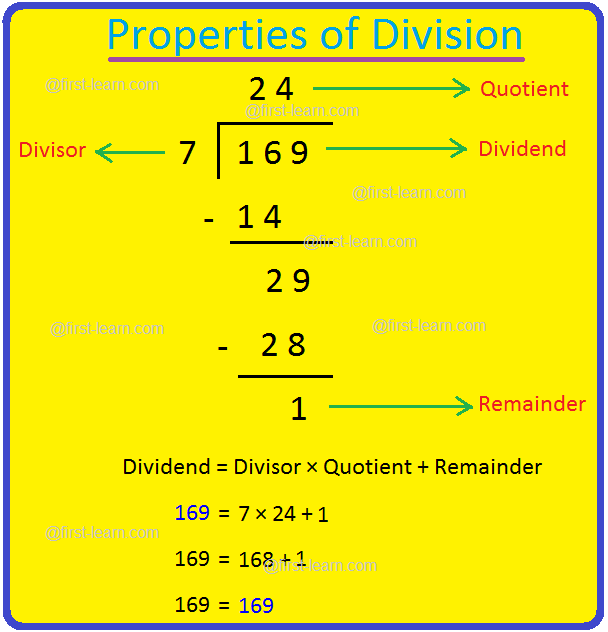Properties of Division
There are few properties of division like other basic operations (such as addition, subtraction and multiplication) which are helpful in better understanding of the concept and ideas. These properties will help the learners in easier understanding and even for the purpose of self checking the division problems done. Each of the properties is narrated below:
1. If any whole number (other than zero) is divided by itself then the answer or the quotient is one.
For Example:
(i) 5 ÷ 5 = 1
Again, as we know that division is an inverse of multiplication hence 5 = 5 × 1
(ii) 25 ÷ 25 = 1
Again, as we know that division is an inverse of multiplication hence 25 = 25 × 1
2. If any whole number (other than zero) is divided by 0 then it is undefined or meaningless
For Example:
(i) 47 ÷ 0 = undefined
(ii) 5 ÷ 0 = undefined
(iii) 225 ÷ 0 = undefined
3. If zero divided by a non- zero whole number, the answer is zero.
For Example:
(i) 0 ÷ 5 = 0
(ii) 0 ÷ 10 = 0
(iii) 0 ÷ 50 = 0
4. If any non zero whole number is divide by 1, then the quotient will be the whole number itself.
For Example:
(i) 5 ÷ 1 = 5
(ii) 23 ÷ 1 = 23
(iii) 15 ÷ 1 = 15
5. If any whole number (other than zero) is divided by another non-zero whole number, the quotient is not necessarily a whole number.
For Example:
(i) 25 ÷ 2 = 12.5
(ii) 10 ÷ 3 = 3.333
(iii) 27 ÷ 4 = 6.75
So, in these cases we can see that a whole number is divided by another whole number and the result is not a whole number. The answer is in decimal.
6. If there are three whole number out of the three one is dividend, another divisor and other is quotient. Now if the divisor and the dividend is not zero then divisor multiplied by quotient is dividend.
For Example:
(i) 25 ÷ 5 = 3
Here, 25 is the dividend, 5 is the divisor and 3 is the quotient.
Now according to the property divisor multiplied by quotient is the dividend
So, 5 × 3 = 15
(ii) 50 ÷ 10 = 5
Here, 50 is the dividend, 10 is the divisor and 5 is the quotient.
Now according to the property divisor multiplied by quotient is the dividend
So, 5 × 10 = 50
iii) 39 ÷ 13 = 3
Here, 39 is the dividend, 13 is the divisor and 3 is the quotient.
Division Equation: Dividend = Divisor × Quotient + Remainder
Now according to the property divisor multiplied by quotient is the dividend
So, 13 × 3 = 39
169 ÷ 7
Dividend = Divisor × Quotient + Remainder
= 7 × 24 + 1
= 168 + 1
= 169
7. If there are three whole numbers (other than zero) p, q and r. If q × r = p, then p ÷ r = q and p ÷ q =r
For Example:
(i) 8 × 6 =48
Then, 48 ÷ 6 = 8 and
48 ÷ 8 = 6
(ii) 9 × 5 = 45
Then, 45 ÷ 5 =9 and
45 ÷ 9 = 5
From Properties of Division to HOME PAGE
Recent Articles
-
What Is Plasma? | Blood Plasma | Proteins | Nutrients | Cholesterol
Nov 07, 25 10:29 AM
Blood is a mobile fluid which is a connective tissue and is derived from the mesoderm like cell any other connective tissue. Colour of blood is reddish and that flows inside the blood vessels by means… -
Disorders of Respiratory System | Tuberculosis | Pleurisy | Emphysema
Oct 28, 25 11:39 PM
Tuberculosis is very common disease and is caused by a type of bacteria called Mycobacterium tuberculosis. This disease causes different trouble in the respiration and infection of several parts of th… -
Regulation of Respiration | Respiratory Centres | Inspiratory Area |
Oct 14, 25 12:13 AM
Respiratory Centre is the area that controls the rate of respiration and it is observed to be located in medulla oblongata and pons. Respiratory Centre has the following will dispersed components like… -
Explain Transport of Gases | External Respiration | Tissue Respiration
Oct 09, 25 11:35 PM
In humans gaseous exchange is completed in the following ways the steps are - External Respiration or Breathing - Breathing in false taking in of Oxygen and giving out of carbon dioxide in the body. M… -
Kind and Number of Teeth | Location of Teeth in Mouth | Care of Teeth
Sep 11, 25 12:52 AM
Kind and Number of Teeth






New! Comments
Have your say about what you just read! Leave me a comment in the box below.